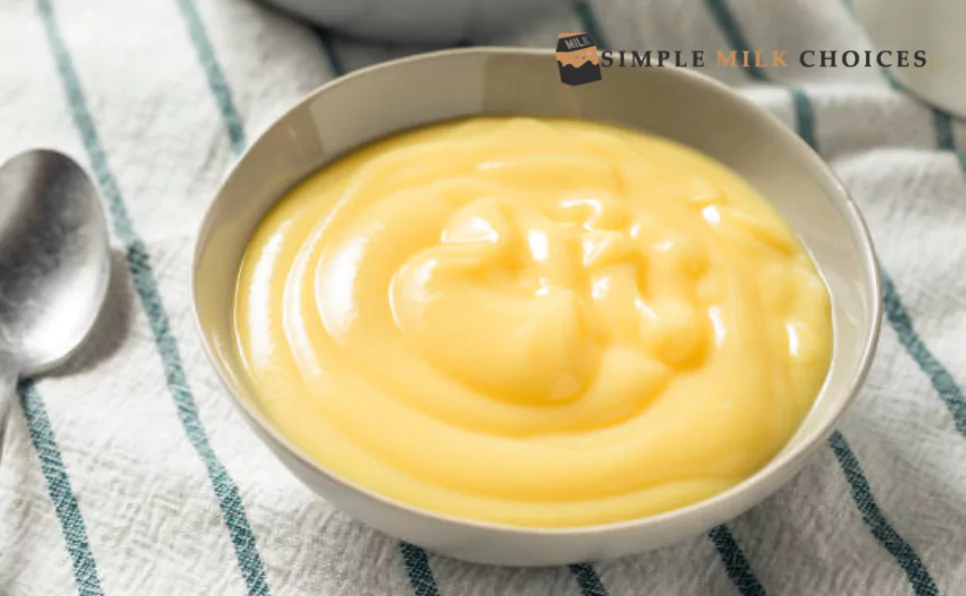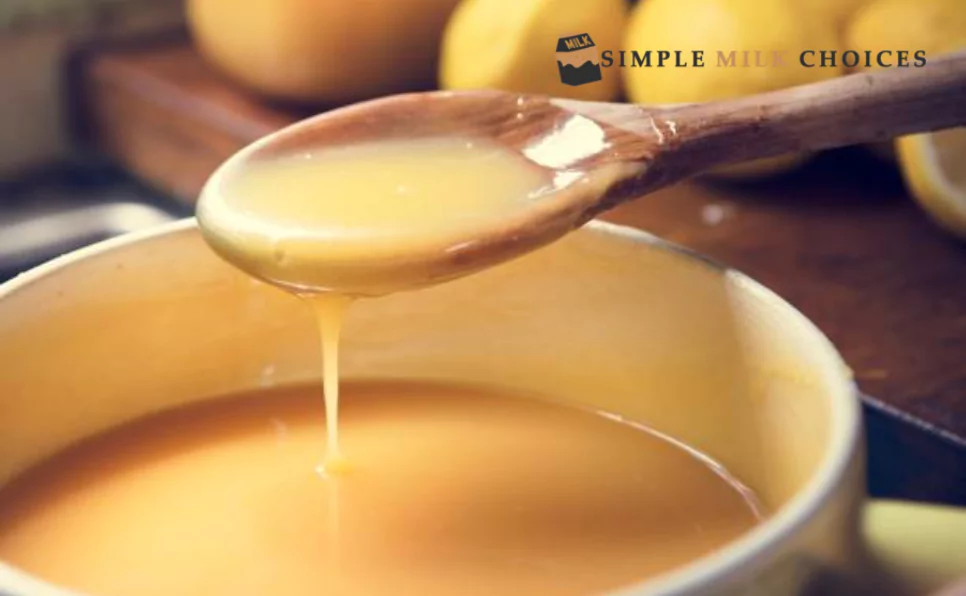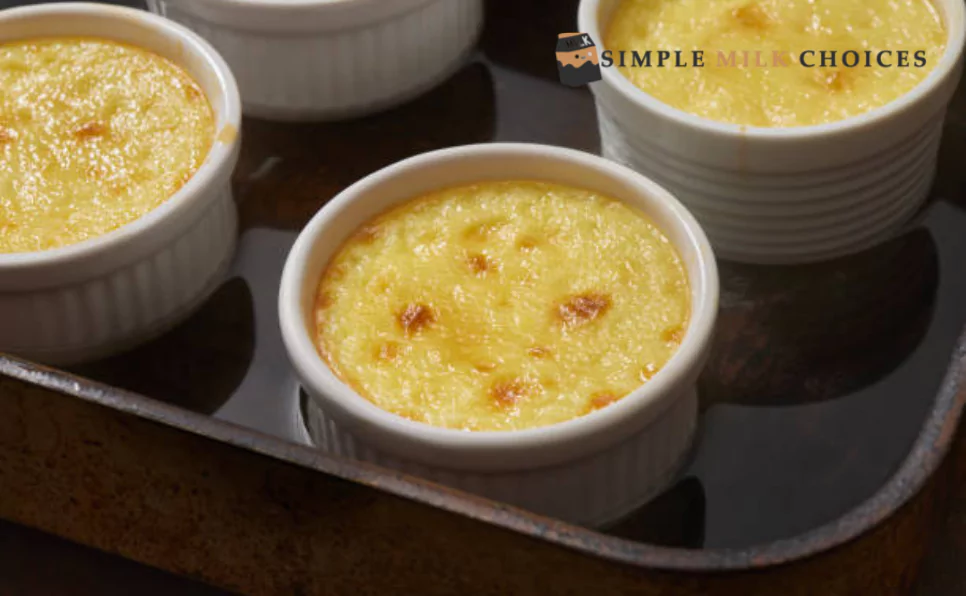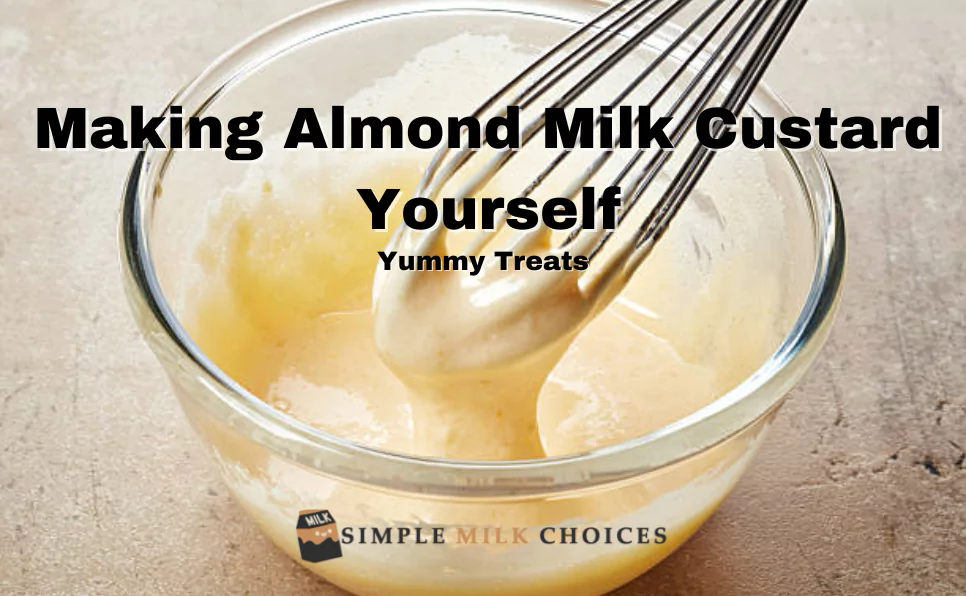Custard comes in a wide range of types and styles from around the world. There’s the velvety and smooth kind from France and the firmer sort from Spain. Individuals utilize a couple of essential ingredients like eggs, sugar, and milk to make custard; however, achieving the perfect taste and texture, especially when experimenting with alternatives like almond milk custard, can be a bit tricky.
Benefits of Utilizing Almond Milk in Custard
Almond milk, made from ground almonds and water, has gained popularity owing to its various medical benefits and distinct flavor profile. Unlike traditional dairy, almond milk offers a lighter choice with a hint of nuttiness, lifting the custard’s taste while aligning with specific dietary preferences, such as lactose intolerance or vegan diets, making it a healthier alternative to traditional milk.
Medical Advantages
Almond milk brings a large group of health benefits compared with traditional dairy. It’s lighter in calories, making it an extraordinary choice for those managing their weight. Additionally, it’s lactose-free, reasonable for people with lactose intolerance, and offers a dairy-free choice for veggie lovers.
Flavor Improvement
The particular taste of almond milk adds an inconspicuous nuttiness to custard, enhancing its flavor profile. This adds a unique dimension to the pastry, making it stand apart from custards made with normal milk.
Dietary Contemplations and Versatility
Almond milk takes care of different dietary preferences and restrictions, expanding the crowd for custard. A flexible alternative squeezed into lactose-free, dairy-free, and vegetarian counts calories, allowing a wider crowd to enjoy this classic dessert without compromising taste or surface.
Nutritional Profile
Almond milk is frequently sustained with nutrients and minerals like calcium, vitamin D, and vitamin E, offering healthy benefits similar to conventional milk. These extra supplements add to the general medical benefits when utilized in custard recipes.
Lower Allergy Risk
Almond milk provides a safe and delicious alternative for individuals allergic to dairy, reducing the risk of allergic reactions often associated with traditional milk-based custards. Furthermore, the concern about almond milk causing allergies is common among those seeking dairy alternatives. However, almond milk tends to be less allergenic compared to dairy, offering a safer option for many.
Choosing the Right Ingredients
The nature of the fixings essentially impacts the custard’s result. With regards to almond milk, searching for natively constructed versus locally acquired choices can influence flavor and texture. Additionally, choosing fresh eggs, quality sugar, and reciprocal flavorings adds to the custard’s general wealth and depth.
1- Almond Milk
This is the star ingredient, replacing traditional dairy. You have choices here—homemade almond milk or store-bought Homemade could give a more particular flavor; however, the store-bought assortment can save time. Search for unsweetened almond milk to control the sweetness of your custard.
2- Eggs
Fresh, excellent eggs are essential. They acquire richness and help thicken the custard. They’re similar to the magic that binds everything.
3- Sugar
Whether it is white sugar, earthy-colored sugar, or options like honey or maple syrup, it is critical to improve your custard. It’s not just about sweetness; it influences the texture and mouthfeel as well.
4- Flavorings
Vanilla concentrate, almond partition, or different flavorings add that extra oomph to your custard. They’re similar to the flavors in your favorite dish—they make it stick out.
Picking these ingredients includes thinking about their quality, freshness, and how they complement one another. Finding equilibrium makes custard that is velvety, delightful, and has the perfect degree of pleasantness.

8 Easy Steps: Creating Custard with Almond Milk
Making custard using almond milk involves a fastidious process. From setting up the custard base to infusing it with almond milk and achieving the perfect consistency through exact cooking procedures, a step-by-step guide ensures a smooth and rich result that spellbinds the sense of taste.
Step 1: Preparation
Gather all your ingredients—almond milk, eggs, sugar, and any flavorings like vanilla concentrate or flavors. Ensures they’re undeniably estimated precisely.
Step 2: Make the Custard Base
In a blending bowl, whisk together the eggs and sugar until they’re very well combined and marginally foamy. This blend shapes the base of your custard.
Step 3: Warming the Almond Milk
In a pan, heat the almond milk on low to medium heat. You need it warm, not bubbling. This step injects the almond milk with any additional flavors and ensures it mixes well with the eggs and sugar.
Step 4: Combining the Ingredients
Slowly pour the warm almond milk into the egg and sugar combination while whisking continuously. This should be done step by step to keep the eggs from souring. The point is to make a smooth, consistent blend.
Step 5: Cooking the Custard
Move the combined mixture back into the pan. At low intensity, consistently stir the mixture. This step requires patience; the custard needs delicate intensity and consistent blending to thicken without curdling.
Step 6: Testing for Consistency
To know when the custard is ready, dip a spoon into the mixture and run your finger down the back. If the line stays and the custard doesn’t run back together, it’s done. Eliminate it from heat right away.
Step 7: Cooling and Setting
Allow the custard to cool somewhat before moving it to a serving dish or individual ramekins. Cover the custard with saran wrap or material paper directly on its surface to keep the skin from shaping. Refrigerate it until completely set and chilled.
Step 8: Serve and Appreciate
When the custard is well-cooled, it’s fit to be served! You can decorate it with fresh natural products, a sprinkle of flavors, or nuts for added flavor and show.
Remember, being patient and gentle is really important. If you rush, your custard might not turn out smooth or could get all lumpy. By following these steps carefully, you’ll get a creamy custard that has a subtle nutty taste from the almond milk.
Investigating Normal Issues
Making custard with almond milk can once in a while present difficulties, yet understanding these issues and how to fix them ensures your custard turns out perfect every time.
Curdling or Splitting
Sometimes the custard could separate or shape bumps, creating an upsetting texture. To prevent this, it’s important to warm the almond milk tenderly and keep away from unexpected temperature changes. If it starts to curdle, quickly remove it from its intensity and whisk energetically to bring it back together. Stressing the custard through a fine strainer can likewise assist with salvaging it.
Changing Sweetness or Thickness
If the custard turns out excessively sweet or not thick enough, fixing this is conceivable. To lessen sweetness, consider adding somewhat more almond milk or diluting it with unsweetened almond milk. To thicken it, delicately stew just a tad longer while consistently mixing until it arrives at the ideal consistency.
Achieve Smooth Texture
Sometimes, custard might end up with a grainy or knotty texture. This could occur because of inappropriate blending or cooking at too high a temperature. To ensure a smooth surface, whisk the custard blend completely before cooking, and cook it over low heat while continuously stirring. Stressing the custard before chilling can also assist with eliminating any lumps.

Flavor Varieties and Enhancements
Trial and error is at the core of culinary creativity. Integrating assorted flavors, adding garnishes or blend-ins, or implanting flavors into the custard presents a valuable chance to personalize the pastry and take special care of different preferences.
Imagine custard as a fresh start fit to be infused with exciting preferences and texture:
Incorporating Various Flavors
You can try different flavors to add an extraordinary touch to your custard. Consider exemplary decisions like vanilla, chocolate, or fresh fruit extracts like strawberry and mango, or significantly more fascinating choices like cardamom or lavender. These flavors can be added during the cooking process to mix the custard with their essence.
Adding Garnishes or Blend-ins
Garnishes and blend-ins offer an additional layer of indulgence. Consider sprinkling squashed nuts like almonds or pistachios on top for a crunchy contrast to the smooth surface. You could likewise add fresh fruit cuts, a spot of whipped cream, or a shower of caramel or chocolate sauce for additional flavor and visual allure.
Trying Different Things with Flavors or Corresponding Ingredients
Flavors and other corresponding fixings can lift the custard’s taste profile. A spot of cinnamon or nutmeg can add warmth and depth to the custard. Additionally, injecting citrus zing, similar to lemon or orange, can acquaint an invigorating turn with the treat.
This part of the custard recipe guide is all about being creative and encourages you to explore lots of different flavors and ways to mix things up. It’s about adding your own flair and trying out different stuff to make custard that matches your own likes and tastes. Whether it’s just a bit of vanilla or mixing in some unexpected flavors, this is where the magic happens to make a custard that’s really special and tastes amazing.
Serving and Presentation
The introduction of custard assumes a huge part in hoisting the dining experience. Understanding the ideal serving temperature, stockpiling tips, and imaginative plating thoughts ensures an outwardly engaging and welcoming treat for any event.
Serving
Serving includes how you present the custard to your guests or appreciate it yourself. It incorporates:
Portioning: choosing how much custard to serve in each dish or bowl. It’s tied in with getting the perfect sum, so it looks welcoming without overpowering the eater.
Temperature: Custard is often best served chilled or at a slightly cool temperature. Ensure it’s at the right temperature when served, which is pivotal for the best taste and texture.
Picking Serving Dishes: Choosing the right dishes, cups, or plates that complement the custard This can range from elegant glassware to enchanting clay bowls, contingent upon the event and your style.
Presentation
The show refers to the overall appearance of the custard dish. It includes:
Garnishing: Add decorative elements on top of the custard, similar to a sprinkle of ground cinnamon, a few berries, a mint leaf, or a shower of chocolate syrup. These embellishments add visual allure as well as additional flavors and surfaces.
Plating Strategies: Arrange the custard inventively on the plate or bowl. You could decide on a whirl design, layering it with fresh fruits, or utilizing a channeling sack to improve shapes.
Aesthetics: paying attention to the general look and feel of the dish. Ensuring the show is spotless, perfect, and inviting. The objective is to make the custard look so appealing that individuals can hardly hold back from diving in!
Accompaniments: taking into account serving it with reciprocal things like a side of treats, a dab of whipped cream, or a sprinkle of nuts. These additions can improve the overall enjoyment of the custard.
Basically, how you serve and present your custard is about making it taste great and look fantastic. It’s like dressing it up for a special occasion, making it look as good as it tastes!

Discovering Custard Everywhere: Different Tastes and Traditions
Worldwide Varieties of Custard
Custard isn’t bound to one style or flavor—it’s a dessert with many faces! From the delicious French crème brûlée to the velvety Spanish flan, custard takes on assorted textures and flavors across different cooking styles.
Social Importance
In various societies, custard holds extraordinary significance. In certain spots, it’s a celebratory pastry served during exceptional events or celebrations. For example, in Britain, custard is a staple complement to numerous pastries like puddings and pies, while in Asia, varieties like the Chinese egg custard tarts or the Filipino leche flan grandstand custard’s transformation to nearby preferences.
Conventional Recipes with Almond Milk
The utilization of almond milk in custard isn’t restricted to one district. A few societies have been integrating almond milk into custard recipes for a long time, adding a nutty aspect to this exemplary treat. For instance, Center Eastern food flaunts almond milk-based custards, such as Mahalabiya, a fragrant and fragile sweet seasoned with rosewater or orange bloom.
Local Transformations and Turn
Each district adds its contort to custard! Whether it’s adding nearby flavors, fresh fruits, or remarkable flavorings, custard adjusts to accessible fixings and social inclinations. In Latin America, coconut custard with traces of cinnamon is a darling treat, exhibiting how local flavors impact custard production.
Combination of Traditional and Current Impacts
In present-day times, custard has additionally been seen in combination with different foods. For example, in Japan, matcha green tea custard mixes traditional custard with the contemporary ubiquity of matcha, bringing about a magnificent and remarkable sweet experience.
Adjusting to Dietary Inclinations
Custard has changed to fit different diets and needs. As more people can’t have dairy or choose not to eat animal products, almond milk custard has become an option. It shows how custard changes to fit what people can eat.
Observing Variety in Treats
Generally speaking, investigating custard in various cooking styles and societies reveals the extravagance of the culinary variety. It shows how a simple treat changed, adapted, and became important in different cultures and celebrations all around the world.
Frequently Asked Questions (FAQ's)
Why use almond milk in custard?
Almond milk offers a non-dairy alternative with a unique flavor and texture, taking care of dietary preferences and providing added medical benefits.
How would I prevent curdling or splitting while using almond milk?
Strategies like gradual warming and delicate blending can help prevent curdling. Involving a thickening specialist like cornstarch might also help with achieving a smoother texture.
Can I substitute almond milk for regular milk in any custard recipe?
Yes, almond milk can typically supplant normal milk in custard recipes. You might need to adjust sweetness or thickness because the texture varies.
Does almond milk essentially adjust the kind of custard?
Almond milk adds a subtle nutty feeling to the custard, upgrading its flavor profile without overpowering it. It supplements the flavor of traditional custard ingredients.
Master Tips
Progressively Consolidate Almond Milk
While adding almond milk to your custard blend, pour it slowly while consistently racing to ensure a smooth mix and keep clumps from framing.
Use Quality Almond Milk
Choose great almond milk, whether locally acquired or homemade, to ensure a more extravagant and reliable flavor in your custard.
Experiment with flavors
Almond milk custard is flexible. Take a stab at mixing various flavors like vanilla, cinnamon, or citrus zing to make one-of-a-kind varieties that suit your taste preferences.
Keep at it! Getting the perfect custard might take a while. Cook it slowly on low heat, stirring a lot, so it stays smooth and doesn’t get too hot.
If it’s not sweet enough, you might notice almond milk is less sweet than regular milk. Before cooking, taste your custard mix and add more sugar if you need to.
Conclusion
The marriage of custard and almond milk uncovers a delectable fusion that captivates palates and offers a fresh interpretation of a cherished work of art. With its flexibility, medical benefits, and culinary potential, almond milk custard remains a demonstration of development in dessert production. Empowering perusers to embrace trial and error and partake in the magnificent excursion of custard creation, this mix ensures a delectable experience for all sweet lovers.





